Although Roman forts were primarily military bases, they were also home
to the troops who garrisoned them, together with a retinue of dependants
and camp-followers. All had to be fed and clothed, and, since the soldiers’
relatively high rates of pay gave them considerable purchasing power,
provided with a wide range of goods and services.
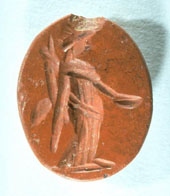 |
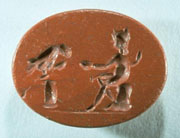 |
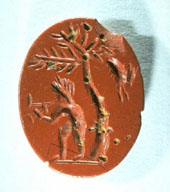 |
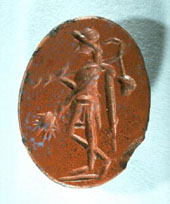 |
These
carved jasper stones, or intaglios, were used like modern signet
rings to impress the owner's mark or good-luck sign. All are from
Newstead. They show, from left to right: Fortuna, with
her pan and horn of plenty; Gannymede offering a cup to Jupiter's
eagle; a satyr playing his pipes beneath a tree; and Bonus Eventus
- the spirit of success - holding ears of corn and a bunch of grapes. |
|||
In the early stages of occupation, when the forts were being set up, most of the troops were probably unaccompanied by families or followers, although the size of the commanding officers’ quarters suggests that they brought substantial households with them. Letters found at Vindolanda in Northumberland show that the commanding officer of the Ninth Batavian Cohort, stationed there in the 90s, was accompanied by his wife Sulpicia Lepidina.
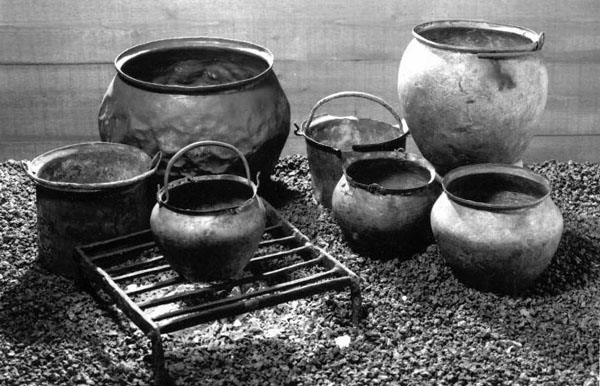
Bronze cooking-pots and a gridiron from
Newstead.
© SCRAN/National Museums of Scotland
The Roman army was adept at self-sufficiency. At Inchtuthil the legionaries exploited local resources of wood, stone, gravel, and clay to build their fortress. They manufactured their own lime, bricks, and pottery on the spot. Food and other raw materials such as leather would have been obtained from the natives, probably in the form of tax. The massive granaries at Inchtuthil hint at the scale of such levies. In addition, the troops probably kept their own flocks and herds: the annexe outside the late first century auxiliary fort at Elginhaugh may have been used for managing livestock as well as for processing grain.
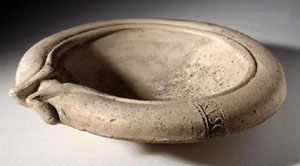 |
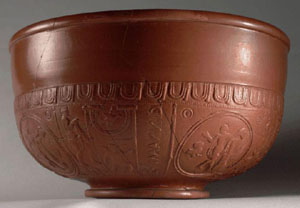 |
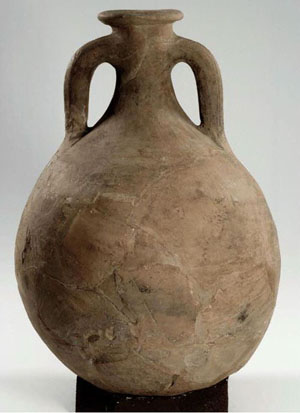
Pottery from Newstead: (top left) a mortarium
or food preparation bowl; (bottom left) a decorated samian bowl from
Central Gaul; (right) an amphora from southern Spain, probably
used for wine or oil.
All © SCRAN/National Museums of Scotland
While much could be obtained locally, some luxuries had to be brought from further afield. Amphoras from Gaul and Spain indicate the import of wine and oil from these areas, while exotic foodstuffs such as figs, dates, and spices may have come from even further afield. Mass-produced samian pottery from Gaul also found its way in large quantities to the northern military zone.
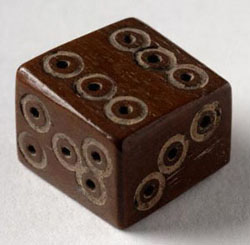
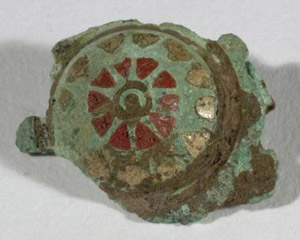
A bone die from Newstead. Games
of chance were popular with the troops.
© SCRAN/National Museums of Scotland
Enamelled bronze disc brooch,
found at Newstead.
© SCRAN/National Museums of Scotland
Although civil settlements or vici have been found adjacent to forts in northern England, and elsewhere in the empire, very few have been identified in Scotland. Perhaps this is because most of their buildings were lightly constructed of timber which was never subsequently replaced by stone, as was the case further south. But in the 1980s geophysical surveys and excavations in the annexes surrounding the fort at Newstead revealed an extensive shanty-town of timber structures set along wide streets. Some of these buildings seem to have been domestic, and perhaps housed soldiers’ families. Others may have been shops, taverns, and other places of entertainment for the troops. Yet others show evidence of industrial or agricultural use.
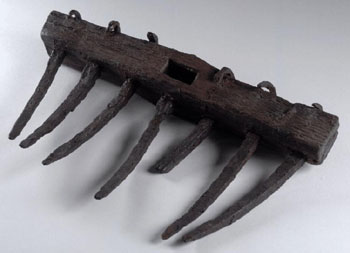
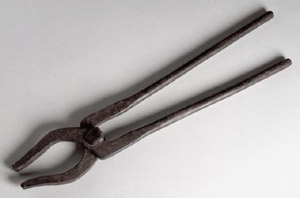
A wooden rake from Newstead.
© SCRAN/National Museums of Scotland
Blacksmith's tongs from
Newstead.
© SCRAN/National Museums of Scotland
On the frontier, it appears, Roman forts generated their own networks
of economic activity, trading with each other and further afield to secure
the high standards of living and material comforts to which the soldiers’
rates of pay entitled them. The natives no doubt underpinned this boom
with tributes of grain, livestock, and slaves, though they probably derived
little direct benefit from it. Military control and economic exploitation
evidently went hand-in-hand.